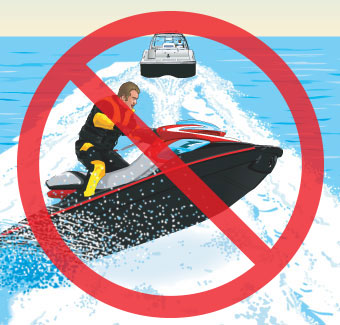
You are the stand-on vessel but be prepared to give way if necessary. What should a sailboat operator do when approaching a PWC head-on.
The boat being overtaken.
A sailboat and a pwc are meeting head on. The Iphone 5C is Iphone 5Colorful 5c may signify the amount five hundred c is that the number for 100 or for five degrees Anders Celsius centigrade once a watercraft and a pwc square measure meeting head on the watercraft is that the stand on vessel. A PWC or personal watercraft is that the fall down vessel to any sailing vessel. Aug 10 2021 A motorboat and a pwc are meeting head-on.
Which one is the stand-on vessel. The sailboat is a stand-on vessel. PWCs are power-driven and fast and therefore the sailboat is a stand-on.
If the sailboat is also power-driven. A motorboat and a pwc are meeting head-on. Which one is the stand-on vessel.
The sailboat is a stand-on vessel. PWCs are power-driven and fast and therefore the sailboat is a stand-on. If the sailboat is also power-driven then both vessels should avert the directions.
Other exceptions may include the depths and hazards present in the situation. Maintain course and speed but stay alert. A sailboat and a PWC are meeting head-on.
What action must be taken when a motorboat is crossing paths with a PWC. The PWC should speed up and attempt to cross in front of the motorboat. The vessel on the port left should give way.
The slower-moving vessel should give way. A sailboat and a PWC are meeting head-on. Which one is the give-way vessel.
Sailboat PWC neither both. A PWC is overtaking another vessel. Which vessel must give way.
The vessel creating the least wake the PWC the slower vessel the faster vessel. What do two short blasts of a horn mean. The PWC should speed up and attempt to cross in front of the motorboat.
The vessel on the port left should give way. The slower-moving vessel should give way. What should a sailboat operator do when approaching a PWC head on.
Neither vessel is the stand-on vessel. A sailboat and a PWC are meeting head -on. What should you do when approaching another vessel head on.
When two power driven vessels are approaching head -on or nearly so either vessel shall indicate its intent which the other vessel shall answer promptly. In a meeting situation neither vessel is the stand-on vessel. A sailboat and a PWC are meeting head-on.
What should a powerboat do when crossing paths with a sailboat. If operating a power-driven vessel you must always give way to a sailing vessel unless the sailing vessel is overtaking your vessel. A motorboat and a PWC are meeting head-on.
Which one is the stand-on vessel. One boat is overtaking another. Which boat must give way.
The faster boat b. The larger boat c. The boat that is overtaking d.
The boat being overtaken. Which side of a boat has a red light at night. A sailboat and a PWC are meeting head-on.
Which one is the stand-on vessel. Sailboat PWC neither both. One boat is overtaking another.
Which boat must give way. The faster boat the larger boat the boat that is overtaking the boat being overtaken. The boat that is overtaking.
You are out on the water in foggy conditions. The boats are shown closer to each other than they should be when actually encountering another vessel on the water. Neither vessel is the stand-on vessel.
Both vessels should turn to starboard the right. The vessel on the operators port left side is the give-way vessel. You are the stand-on vessel but be prepared to give way if necessary.
A sailboat is approaching head-on but you have the right of way. A power-driven vessel is approaching head-on but you have the right of way. You are the give-way vessel in a head-on situation.
Sound a horn and tack. The PWC is a FAST powered watercraft most likely without a radio and noisey enough to not hear your warning and as such is required to yield the right of way to a vessel under sail. By tacking however you 1.
When a PWC and a motorboat are about to meet head-on each vessel should move to the starboard side and pass in a normal traffic pattern Pass with the other vessel to port Vessels crossing paths When a PWC wishes to cross the path of a motorboat the direction of the approach is the factor that determines which one has the right of way. According to Texas law during what hours is it LEGAL for a boat other than a PWC to tow a person on water skis. One-half hour before sunrise to one-half hour after sunset Which of the following would be required when towing a person on water skis behind a.
Most fatalities involving a PWC result from injuries caused by collisions and not from drowning. Maintain present course and speed. Avoid crossing in front of other vessels.
What should a sailboat operator do when approaching a PWC head-on. A sailboat is approaching head-on but you have the right of way. A sailboat and a PWC are meeting head on which one is the stand on vessel.
When a sailboat overtake a powerboat which vessel is the stand on vessel.
